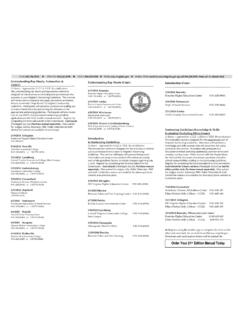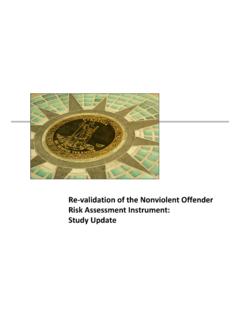Transcription of Community Corrections Alternative Placement (CCAP)
1 Community Corrections Alternative PROGRAM CCAP Operated at VADOC s Detention & Diversion Centers PURPOSE VADOC is transforming its Detention and Diversion Center programs to bring them in line with current evidence-based practices. The changes will provide enhanced, individualized services for offenders on probation and better meet the needs of the sentencing courts. HISTORY Detention and Diversion centers were created in 1995 along with our Bootcamp Program which was for younger offenders. The general model for these facilities was based on military style regimen, coupled with remedial education, life skills and education.
2 Boot Camp closed 2002 Chatham Diversion and White Post Diversion Closed HISTORY At our peak of operation VADOC had 930 beds dedicated to Detention and Diversion we have 523 beds available in 5 programs. Our objective was to identify non-violent felon offenders who needed more than regular probation but less than incarceration. All participants were technically probationers so if they did not comply with the program requirements they would be arrested on PB-15 and returned to court. PROGRAM EVALUATION In 2013, as a part of a Justice Reinvestment Initiative, the programs were evaluated by the Council for State Governments to determine effectiveness.
3 Findings: Programming not sufficient to change behavior Groups not using evidence based practices Talking cures being used instead of sound practices Emphasis on sanctions rather than balance with positive behavioral reinforcements Acquisition of proven skills and pro-social thinking were not requirements of graduation Programming lacking fidelity PROGRAM EVALUATION Most Important Findings: Over 40% of the population sentenced to the program was low risk to reoffend EBP Principle: Don t mix Low risk and High Risk Offenders in program! EBP Principle: Don t use intensive resources on Low risk offenders! 45% of Low risk offenders were rearrested within 2 years of release.
4 65% of High risk offenders were rearrested within 2 years of release. INTERNAL EVALUATION In repeated internal studies, graduates of Detention and Diversion Centers did not perform as well as control groups sentenced to jail or prison. Overall Detention and Diversion Center Graduates two year re-arrest rate was compared to for the Jail Control Group and for the Prison Control Group. Overall Detention and Diversion Center Graduates three year re-arrest rate was compared to for the Jail Control Group and for the Prison Control Group. INTERNAL EVALUATION How do these programs compare to other facilities relative to cost?
5 Work Centers Per Capita Cost = $20,960 Field Units Per Capita Cost = $27,611 Major Institutions Per Capita Cost = $29,416 Detention and Diversion Center Per Capita Cost = $31,722 Source: VADOC FY2016 Management Information Summary Report WHY CHANGE? We want programs that reduce crime in our communities! We want to be good stewards of tax payers dollars! We want our employees to perform services that are effective! We want our courts and other critical stakeholders to have confidence in our treatment services! WHAT WILL REMAIN THE SAME Probation Officers will continue to coordinate the referral process and complete initial screening requirements Daily operations & facility structures will remain the same.
6 Offenders will continue to be held accountable; if needed, they will receive institutional charges. Offenders are expected to communicate with staff and others in a professional manner. Offenders will continue to have opportunities to perform Community service and/or work in the Community NEW ELEMENTS OF CCAP Centralized Referral Unit Enhanced Programming to address individual risk, needs, and responsivity issues Program completion based on meeting minimum treatment dosage requirement for identified needs Expanded target population CENTRALIZED REFERRAL UNIT All referrals will be processed through a central unit in Richmond Acceptance into CCAP and program assignment (to which Facility)
7 Will be based on individual risk, needs and responsivity Referral unit will oversee any transfers between CCAP facilities that become warranted to better meet treatment needs or noncompliance issues ENHANCED PROGRAMMING Core programming at all facilities Substance Abuse Cognitive Behavioral Treatment Vocation/Education Intensive Substance Abuse Treatment Intensive Cognitive Behavioral Treatment Offenders assessed to have moderate treatment needs must complete a minimum of 200 core treatment hours for successful program completion (approx. 22 - 28 weeks) Stafford Detention & Diversion Center Harrisonburg Detention & Diversion Center Chesterfield Women s Detention & Diversion Center DOSAGE REQUIREMENTS & PROGRAM COMPLETION DOSAGE REQUIREMENTS & PROGRAM COMPLETION Offenders assessed to have high treatment needs for Substance Abuse Treatment and/or Cognitive Behavioral Treatment must complete a minimum of 300 treatment hours for successful program completion (approx.)
8 42 - 48 weeks) Cold Springs Detention & Diversion Center (Intensive Substance Abuse) Appalachian Detention & Diversion Center (Intensive CBT) Chesterfield Women s Detention & Diversion Center (SA & CBT) EXPANDED TARGET POPULATION More inclusive medical admission criteria paired with increased medical coverage and treatment at all facilities Acceptance of offenders with mild mental illness at all facilities CCAP Appalachian Detention & Diversion Center Stafford Detention & Diversion Center Cold Springs Detention & Diversion Center Harrisonburg Detention & Diversion Center Chesterfield Women s Detention & Diversion Center APPALACHIAN DETENTION & DIVERSION CENTER Specialization: Intensive Cognitive Behavioral Treatment Dosage: 300 treatment hours (approx.
9 42 - 48 weeks) Capacity: 106 beds Core Programming: Substance Abuse Treatment Vocation/Education Basic Computer training Welding Masonry COLD SPRINGS DETENTION & DIVERSION CENTER Specialization: Intensive Substance Abuse Treatment Dosage: 300 treatment hours (approx. 42 - 48 weeks) Capacity: 84 beds Core Programming: Cognitive Behavioral Treatment Vocation/Education HARRISONBURG DETENTION & DIVERSION CENTER Core Programming with a secondary work component Dosage: 200 treatment hours (approx. 22 - 28 weeks) Capacity: 125 beds Core Programming: Cognitive Behavioral Treatment Substance Abuse Treatment Vocation/Education STAFFORD DETENTION & DIVERSION CENTER Core Programming with a secondary work component Dosage: 200 treatment hours (approx.
10 22 - 28 weeks) Capacity: 116 beds Core Programming: Cognitive Behavioral Treatment Substance Abuse Treatment Vocation/Education CHESTERFIELD WOMEN S DETENTION & DIVERSION CENTER Capacity: 160 beds Core Programming: Cognitive Behavioral Treatment Substance Abuse Treatment Vocation/Education Multiple treatment tracks: Cognitive Behavioral Treatment Dosage: 300 treatment hours (approx. 42 48 weeks) 2. Intensive Substance Abuse Treatment Dosage: 300 treatment hours (approx. 42 48 weeks) programming with a secondary work component Dosage: 200 treatment hours (approx. 22 28 weeks) BENEFITS OF CCAP Better meet the needs of the sentencing courts Enhance level of programming to address driving factors that lead to criminal behavior Changes are in line with current research Improve communication between referring districts and facilities to enhance re-entry efforts Reduce co-mingling of high and low risk offenders Provides flexibility to modify length of stay based on treatment responsiveness Central referral unit will free staff from administrative screening of referrals, creating more time to provide programming and address probationer needs QUESTIONS?















